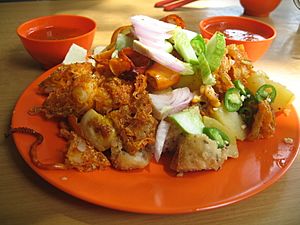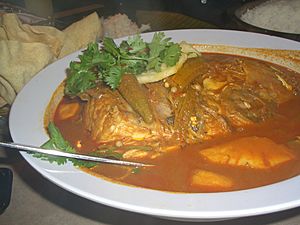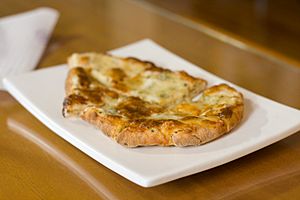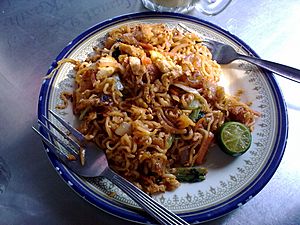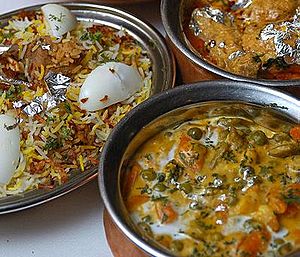Malaysian Indian cuisine facts for kids
Malaysian Indian cuisine is the delicious food created by Indian communities living in Malaysia. It includes both traditional dishes from India and new recipes inspired by Malaysia's many different food cultures. Most Indian people in Malaysia come from South India, especially the Tamil region. This means that much of Malaysian Indian food tastes like South Indian dishes.
You'll often find curry leaves, whole and powdered spices, and fresh coconut in many forms in these dishes. Ghee (a type of clarified butter) is still used for cooking. However, vegetable oils are also common in homes today. Before eating, people often wash their hands because they usually eat with their hands instead of cutlery.
Contents
How is Malaysian Indian Food Eaten?
Eating with Banana Leaves
Since most Malaysian Indians are from South India, they traditionally eat their food from a banana leaf. This "banana leaf meal" is very famous in Malaysia. Imagine rice in the middle, surrounded by tasty side dishes like pickles, fried meat or vegetables, and papadum (crispy lentil crackers). Different curries are served around the rice. It's a feast for both your eyes and your taste buds!
Eating with your hands is a must for this meal. There are also some polite ways to do things. For example, how the leaf is placed in front of you and where the food goes on the leaf.
After you finish eating, how you fold the banana leaf can show if you liked the meal. If you fold the leaf towards yourself, it means you really enjoyed the food. Folding it away from you means you didn't find the meal satisfying.
Chettinad Dishes: Spicy and Flavorful
Chettinad cuisine comes from the Chettinad region in Tamil Nadu, India. It's very popular in Malaysia and you can find it in special restaurants. The traditional cooking of the Chettiar people is different from many vegetarian Tamil dishes. It often uses lots of meat dishes with strong spices. Instead of much coconut milk, they use plenty of onions and tomatoes to make the curries thick and tasty.
Mamak Stalls: A Malaysian Favorite
Mamak dishes have become a unique Malaysian style of food. You can find mamak stalls or restaurants all over the country. They are super popular because they offer many different foods. Some are even open 24 hours a day!
One type of Indian Muslim meal served buffet-style at mamak restaurants is called nasi kandar. It's like an Indonesian dish where you pay for what you eat. You get white rice or biryani rice with different curries. These can have chicken, fish, beef, or mutton. They usually come with pickled vegetables and papadum.
People of all backgrounds love to visit mamak stalls. They go to chat with friends or watch a late-night football game. All while enjoying a hot cup of teh tarik. These stalls are very important to Malaysian culture, just like kopitiams (traditional coffee shops).
Popular Malaysian Indian Dishes
Here are some tasty dishes you might find in Malaysian Indian food:
- Achar: These are Indian pickles made from chopped vegetables or fruits. They are cooked in oil or salty water with many different spices.
- Appam: A bowl-shaped pancake made from fermented rice batter and coconut milk.
- Attukal Paya: This is a mutton (lamb) leg soup. The local version is also known as Sup kambing.
- Avial: A vegetable stew with shredded vegetables cooked in coconut oil. It's seasoned with spices like curry leaves, turmeric, and green chilies. The vegetables are then simmered with coconut milk and a bit of yogurt.
- Biryani or nasi beriani: A flavorful rice dish cooked with mutton, chicken, vegetables, or fish curry. It uses basmati rice. Dum biryani is a version where the spiced meat is baked with the rice.
- Butter chicken: A famous dish from Punjab, India.
- Chapati: A type of North Indian flatbread. It's made from whole wheat flour, water, and salt. You cook it on a hot, dry pan without oil. People usually eat chapatis with vegetable curries. You use pieces of the chapati to pick up the food.
- Chicken 65: A spicy, deep-fried chicken dish from Tamil Nadu. It gets its flavor from ginger, cayenne pepper, mustard, and vinegar. Curry leaves are also very important for its taste.
- Chutney: These are sauces or dips, mainly from South Asia. They usually have a mix of spices, vegetables, or fruits. Chutneys can be wet or dry, and smooth or chunky.
- Fish head curry: This dish has some Chinese and Malay influences. The head of a Red snapper fish is cooked in a curry. The curry has coconut milk and tamarind juice, plus vegetables like lady's fingers and brinjal. It's usually served with rice or bread.
- Fish molee: Originally from Kerala, India. This fish dish is cooked in a spiced coconut gravy. It's probably the most famous dish of the Malaysian Malayalee community.
- Kurma: In Malaysia, kurma is usually chicken or mutton cooked with ground spices, nuts, and coconut milk. You can often find pre-mixed "kurma powder" to make it easy.
- Idli: These are steamed patties made from lentils and rice. They are usually eaten for breakfast or as a snack. Idli are often served with chutney or sambar.
- Mamak Rojak: A salad with shredded cucumber, potatoes, beancurd (tofu), turnip, bean sprouts, and prawn fritters. It's served with a sweet and spicy nut sauce. Pasembur is a type of Mamak Rojak found in northern Malaysia, especially in Penang.
- Mee goreng: Thin yellow noodles fried with garlic, onions, fried prawns, chicken, chili, tofu, vegetables, tomatoes, and egg.
- Maggi goreng: A version of mee goreng made with Maggi instant noodles.
- Mee goreng mamak: Found at mamak stalls, this version uses spices, tomato sauce, potatoes, and sweet soy sauce.
- Murtabak: A savory stuffed flatbread, usually with minced mutton, garlic, and onion, folded with an omelette. It's eaten with curry sauce.
- Naan: A fluffy, oven-baked flatbread. It's usually eaten with sauces like chutney and curries like dhal curry. Examples include Garlic Naan and Cheese Naan.
- Nasi lemak: The Malaysian Indian version is similar to the original. However, many Malaysian Indians are Hindus, so they don't eat beef. Because of this, beef is usually not in their nasi lemak. There's also a vegetarian version where mock anchovies replace the dried anchovies.
- Nasi Kandar: A meal of steamed rice served with different curries and side dishes.
- Paneer: A type of cheese made without rennet, so it's good for vegetarians. Paneer is not very common in most Malaysian Indian cooking. It's mainly used in North Indian recipes like paneer Tikka and palak paneer.
- Pongal: A boiled rice dish that can be sweet or spicy. It shares its name with the harvest festival in January. The sweet version, made with milk and a type of sugar called jaggery, is cooked in the morning. When it boils over, it's a sign of a good harvest and offered to the gods.
- Poori: An unleavened bread (meaning it doesn't use yeast) usually served with sweet halwa, kurma, or potato-based curries.
- Putu mayam (string hoppers): A sweet dish of rice noodles with coconut and jaggery. It's served with grated coconut and jaggery or palm sugar. In Malaysian Indian homes, it's often eaten with curried dishes or dal.
- Rasam: A type of lentil soup flavored with pepper, coriander, and cumin seeds.
- Roti canai: A type of Indian-influenced flatbread popular in Malaysia and Singapore. It's similar to Kerala porotta. In Tamil, it's called Parotta.
- Roti tissue: Sometimes called Roti Helikopter (Helicopter bread). This is a much thinner version of Roti canai, almost as thin as a large piece of tissue paper.
- Sambar: A thick stew made from lentils and vegetables, seasoned with spices.
- Tandoori chicken: Chicken marinated in spices and yogurt, then cooked in a clay oven.
- Thosai: A pancake made from rice and lentils. There's also a "masala" version with spiced potatoes inside. It's served with different types of sambar.
- Upma or uppuma: A thick porridge from South India, made from dry roasted semolina.
- Uttapam: A savory pancake made from a similar batter as thosai. Toppings like tomatoes, onions, chilies, and cabbage are cooked right into the batter.
- Vada: A small, spicy fritter, often shaped like a donut. It's made from mashed lentils and spices.
- Varuval: A dry dish of pre-cooked meat or vegetables. They are stir-fried in oil with whole and ground spices. Chettinad-style varuval often uses chicken or mutton with lots of spices.
Sweet Treats and Desserts
- Ais kacang: A refreshing dessert with shaved ice. It's traditionally made with a special ice machine.
- Cendol: Smooth green rice noodles in chilled coconut milk with gula melaka (coconut palm sugar).
- Gulab jamun: A sweet dessert often eaten during festivals or big celebrations like weddings and Deepavali.
- Halwa: A dense, sweet, fudge-like candy. It's often flavored with nuts and spices.
- Jalebi: A deep-fried sweet made from wheat flour batter. It's shaped into pretzel or circular forms, then soaked in sweet syrup.
- Laddu: Ball-shaped sweets popular during festive or religious times.
Drinks to Quench Your Thirst
- Badam milk: Milk flavored and thickened with crushed almonds.
- Filter coffee: A sweet, milky coffee made from dark roasted coffee beans and chicory.
- Lassi: A cold yogurt drink served in a tall glass. It can be salty or sweet.
- Masala chai: A drink made by brewing tea with a mix of aromatic Indian spices and herbs.
- Teh tarik: This means "pulled tea" and is a very popular Malaysian drink. Tea is sweetened with condensed milk. The tea maker pours the hot tea back and forth between two mugs, holding their hands far apart. This "pulling" creates a thick foam and cools the tea down. It's quite an art to watch! Similar drinks include kopi tarik (pulled coffee) and teh halia (ginger tea).
Snacks to Munch On
There are many small, savory snacks that are popular with everyone in Malaysia, not just the Indian community. You can still find street vendors selling kacang putih. This is a general name for snacks made from flour, nuts, or beans, roasted or fried with spices.
- Achu Murukku: Also known as Rose Cookies. These are popular during festivals like Diwali and Christmas.
- Banana chips: Deep-fried or dried slices of sweet bananas. They can be sweet (with sugar or honey) or salty/spicy (fried in oil with spices).
- Bombay mix: An Indian snack mix with different spicy, dried ingredients. These can include fried lentils, peanuts, chickpea flour noodles (sev), corn, and curry leaves.
- Bonda: A typical South Indian snack with sweet and spicy versions in different areas.
- Murukku: A savory snack made from a deep-fried spiral of lentil-based batter. It's usually made from a mix of urad (black gram) and rice flour, salt, and flavors like chili and spices. Murukku is traditionally enjoyed during Deepavali.
- Pakora: A spicy Indian snack, similar to potato fritters. It often has a main ingredient like potato or fried onions. It can be a topping on meals or eaten alone.
- Papadum: A thin, crispy, disc-shaped cracker. It's usually made from a seasoned dough of black gram flour, then fried or cooked with dry heat. Papadams are often served with a meal or as a snack on their own.
- Samosa: A fried or baked pastry with a savory filling. Common fillings include spiced potatoes, onions, peas, lentils, or minced meat.


